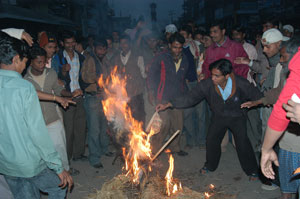|
|
| CAP ON IDENTITY: Student leaders of the seven parties alliance and the Madhesi Janadhikar Forum burn a dhaka topi in Rajbiraj on Sunday. |
Rano Devi Mahato's cries rend the air. She weeps, sobs uncontrollably, her breath faltering. She cries for her lost 16-year-old son whose cheery image stares out of the photo she holds.
She and her grey-haired husband Ravi sit in their dusty yard in a village an hour from Lahan, their palms clasped together humbly. Ravi is composed but seems utterly beaten down by the death of their fourth child, Ramesh, whose shooting in Lahan on 19 January sparked much more violence related to the madhesi cause.
"Ramesh went to Lahan to shop for me and sit his exam," weeps Rano Devi. "Then I heard someone else had been shot but Ramesh was safe. But I went to the clinic and saw his body. People say Maoists killed him, but how would I know?"
There are the usual jumbled accounts of what happened. A man stops us near the Mahato home, saying he witnessed a Maoist firing at Ramesh out of a bus window even as a separate demonstrator tried to drag the Maoist out of the vehicle. More have since died at the hands of the police.
 |
| NOW YOU SEE IT: The streets of the central and eastern tarai, such as this stretch just outside Lahan, are deserted- until they come alive with demonstrator. |
"The pahadis say a madhesi can't be prime minister," bellows Krishna Bahadur Yadav of the Madhesi Janadhikar Forum (MJF). "Well, I challenge them. They've run the country for 238 years. We'll run it for 1,000 years."
The crowd loves it. Yadav enjoys breathing the fiery rhetoric, egging them on with continual swipes of his arm. He is humorous rather than threatening, but he means it when he says madhesis are treated as "stepsons" and that federal government is needed now.
At the time of our visit, the demos could only happen outside curfew hours. When there was no curfew, there was a banda-and still is. South of the central chok there are shards of glass scattered all around. Away to the right are burnt-out hulks of perhaps a dozen buses. Nearer, on the left, are massed armed police, ready in their riot gear and looking nervous. Crows and bicycle rickshaws provide the main sign of life in a town which is replaying its own version of last year's April Uprising.
Perhaps the most wretched of Lahan are its marooned travellers. Hanging around the yard of Hotel Bishal, smiling amiably but sadly, is Amar Kumar Jaiswal. He has been stranded 11 days, and counting. He was simply trying to make the short journey from Birtamod to Janakpur. Government helicopters evacuated some people, he says, but only to Kathmandu. Two cousins, JD and Binod Aggrawal, heading to Biratnagar and Kathmandu respectively, have been there six days and say their only option has been getting on a cement truck which would take them a little further along the highway. They decided to stay put in Lahan, and pay tribute to the kindness of local people in feeding and sheltering them.
 |
| STOP AND GO: Vehicles going from east to west Nepal, such as this one carrying human rights monitors scores blockage, and have to be escorted to the Kosi Barrage by the Armed Police Force. |
There is no one single type of rally. On our first day, at Inaruwa, we are led into a village meeting by the Madhesi Intellectuals' Forum, whose leaders greet us courteously. Reassuringly, they insist the madhesi movement is not ethnic but includes brahmins and dalits, speakers of Hindi, Urdu, Tharu, Bhojpuri, Maithili, and more. But later that day at Mirchaiya, west of Lahan, the mood is darker.
Although most are happy to see us, even in a vehicle, one person smashes our back windscreen to smithereens. The others apologise, but the mood is volatile.
There is far worse elsewhere. Madhesis, with their very real political grievances, have died. But people of pahadi origin are now fleeing their tarai homes, being threatened in what seem like acts of revenge, having their doors and windows smashed, and journalists are having to quit their workplaces after death threats.
The responsible madhesi leaders clearly abhor such violence. But the madhes is burning, and people are scared.



